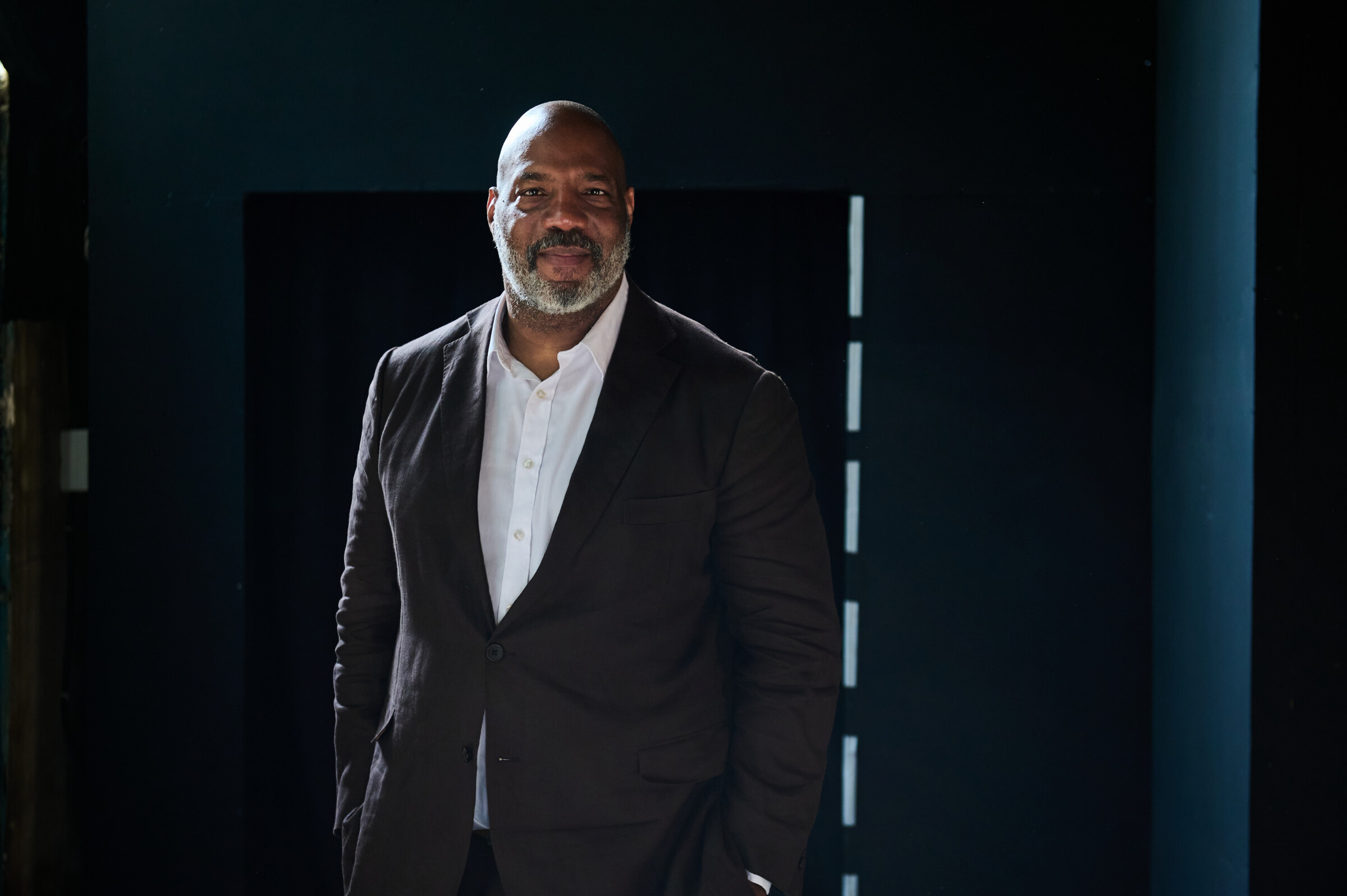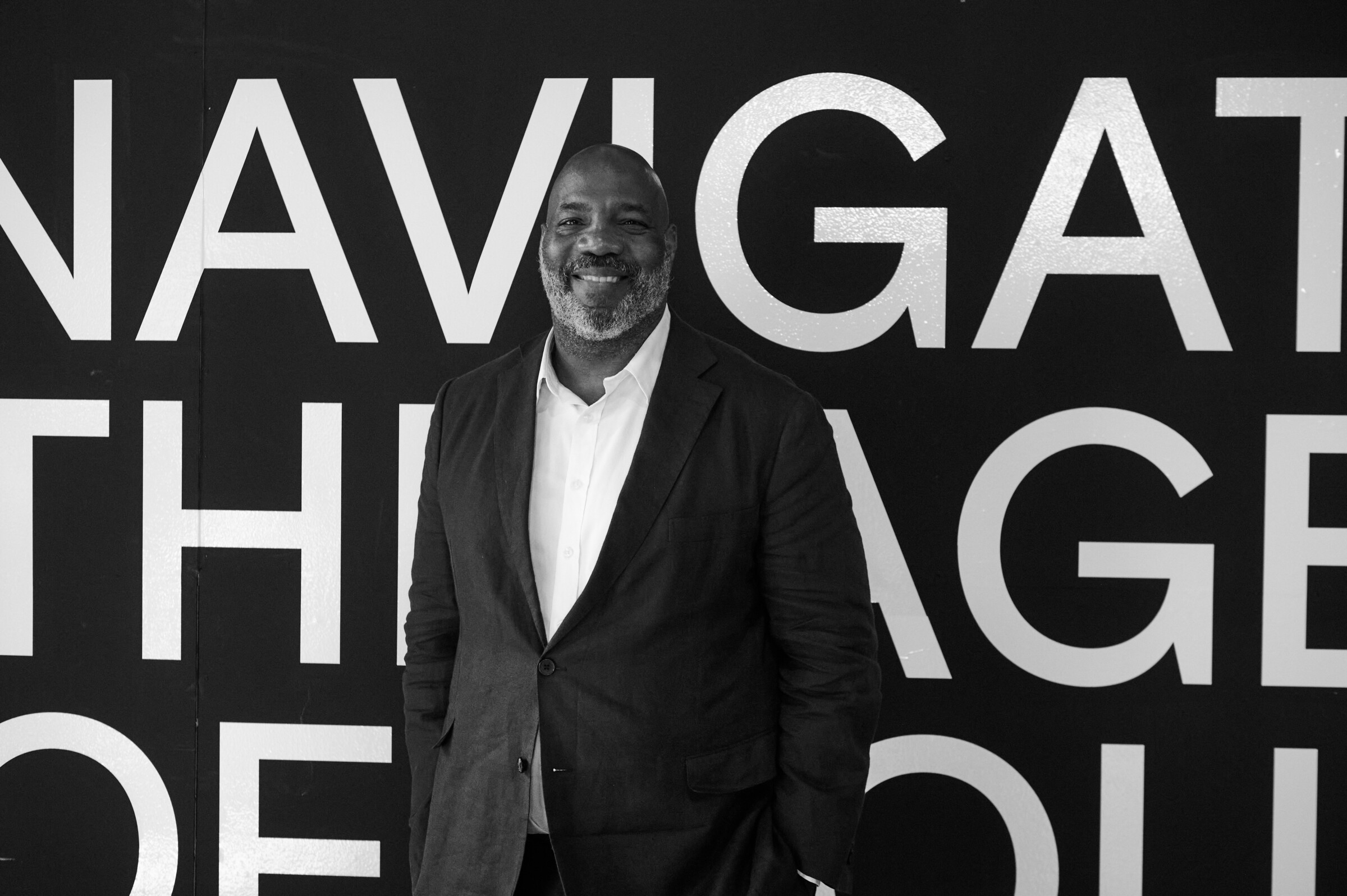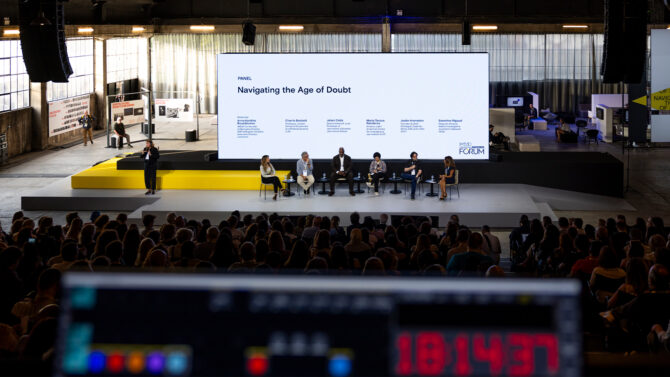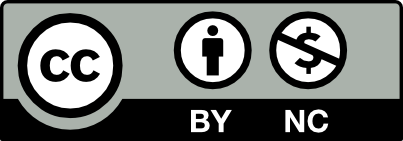Jelani Cobb, Dean of the Columbia Journalism School, author, and longtime staff writer for The New Yorker, speaks to iMEdD about academic freedom in the United States, the challenges facing the press today, so-called “Trump coverage,” and the public interest as journalism’s enduring mission.
Featured image: Petros Toufexis/ iMEdD
He began his career in journalism with an internship at The Washington City Paper, as part of a program that sought to make the newsroom more representative of the city it served — a place where nine out of ten journalists were white, in a community where seven out of ten residents were black.
As a journalist, historian, and author, Jelani Cobb has built an impressive and prolific career devoted to an in-depth chronicle of American society — its racial and political tensions, and, ultimately, its democracy. Since 2022, he has served as Dean of Columbia University’s Graduate School of Journalism in New York, and since 2016, he has been the Henry R. Luce Professor of Journalism. A longtime staff writer at The New Yorker, Cobb received a Peabody Award in 2020 and was a finalist for the 2018 Pulitzer Prize in Commentary.
Today, he continues to articulate a clear and steady vision of journalism’s enduring mission. “Whenever people ask me what journalism is, I say that it’s the art and craft of collecting information and disseminating it in the public interest. We do that as a core function of democracy,” he noted during our meeting in late September 2025, reflecting on the role of the “fourth estate” in today’s polarized era —when truth itself is under question.
Cobb was in Athens, Greece as a speaker at this year’s iMEdD International Journalism Forum, where he participated in the opening panel discussion, “Navigating the age of doubt.” With openness, gentleness in his manner, and directness in his responses, he joined our fifty-minute conversation just a few hours before taking the stage. Our discussion began with a question on many people’s minds — though the occasion was the release of his new book, Three or More Is a Riot: Notes on How We Got Here.
How did we get here?
It’s a complicated question, but in that title, I was thinking about things I have written about at The New Yorker over the past decade that all culminated in a lot of the dynamics we see in American politics specifically. There were social resentments that were building, and racial resentments that began building during the Obama presidency. At the same time, there was economic stagnation and real frustration that didn’t have an avenue in conventional politics in the United States. They became part of a much more belligerent and volatile style of American politics than most people had seen.
This is not the first time we’ve seen this in American history — we’ve had incidents or moments like this before. But most people had not seen anything like this in their lifetimes. I wrote about Dylann Roof, a white supremacist who killed nine people in the basement of a church in 2015. He became a kind of rallying figure on the Internet; people admired him in particular ways. I also wrote about the development of the early 2015–2016 Trump campaign and the dynamics that were going on there. A whole array of these things has congealed into the kind of difficulties and polarization we now see in American politics.

Freedom of speech, inside and outside the University
Recently, two very different cases — Charlie Kirk and Jimmy Kimmel — grabbed intense attention in the U.S. and abroad. If I were a student in a Columbia Journalism School class the day after, what would you say to us?
I wasn’t teaching the day after [Kirk] was shot, but I did talk with students about the idea that a person has a right to say things that are controversial. I disagreed with many of the things that he said, but the entire compact of democracy is supposed to be that […] I don’t think anyone who has a reasonable sense of democracy is comforted by the fact that someone lost their life amid making a public speech.
For Jimmy Kimmel, what happened seemed to emphasize that people had missed the point that what Kimmel said was not particularly inflammatory. But the idea was that people who were seen as being on the left — or thought of being on the left — were going to be silenced. And that happened. Jimmy Kimmel was the most visible example, but there were other people who lost their jobs, people who had been publicly ostracized, and so on.
The biggest concern here is the federal government’s involvement. The federal government has no right or role — specifically prohibited by the Constitution from curtailing people’s ability to exercise their free speech. The fact that the FCC [Federal Communications Commission] was involved, and that the Chair of the FCC said they would do this to more people and more shows, was deeply concerning and remains deeply concerning.
The current climate is challenged in the same way that journalism is. The challenges come from the same sources — one, the federal government, and two, the broader, volatile political climate we’re operating in.
Jelani Cobb, Dean, Graduate School of Journalism and Henry R. Luce Professor of Journalism
How do you view the current climate for academic freedom — at Columbia University and across the United States?
I think the current climate is challenged in the same way that journalism is. The challenges come from the same sources — one, the federal government, and two, the broader, volatile political climate we’re operating in. We’ve seen, at various moments in American history, academic freedom seriously challenged or curtailed — the most notable being during the McCarthy era in the 1950s. Scholars of that period have pointed out the extent to which the moment we are in currently really resembles that time.
As for the landscape of freedom of speech within the institution — at Columbia itself —, in the journalism school where I’m in charge, we are all about freedom of speech and freedom of the press, and therefore academic freedom, all the time. Across the university, it’s no secret that there have been conflicts around these issues: We are attempting to figure out how to navigate the balance between freedom of speech and academic freedom, and the Title VI [of the Civil Rights Act of 1964] protections against discrimination — whether that’s race, gender, sexual orientation, and all the kinds of dynamics. It’s difficult and complicated, and it’s not made any easier by the overreach of the federal government, which has been involved in it in a way that is not helpful. But you know, the university — at least the core constituencies— understand that we have to do both. We have to uphold academic freedom, and we also have to protect our students, staff, and faculty from discriminatory behavior. We’re trying to navigate that.
Almost two years after the student protests, what remains worth keeping in mind —institutionally, in terms of policy, or educationally?
Columbia is an international institution, and we take a lot of pride in that. The other part of it is that conflicts around the world find their way of being reflected on campus. There are students on our campus who have been deeply affected by the Russian invasion of Ukraine. Any significant conflict in the world is going to show up on our campus as well. The war in Gaza was no different.
We have many students from very many different backgrounds. One of the things, I think, people missed, if they were outside, was that it seemed as if there were Palestinian students — or people who were pro-Palestine — on one side, and people who were pro-Israel on the other. On the most basic level, you could see that. But it also [involved many] different constituencies and communities that felt in different ways. There were many Jewish students who participated in the protests, for instance. It was a much more complicated situation for us internally.
What we’ve tried to do is navigate that in a way that still upholds a sense of community —which is fundamentally our strength. That’s taken a bunch of different steps, and this is still a process that is ongoing. We haven’t yet figured out what the right balance of all these things is — how we bring people back together after the very tumultuous time that we’ve experienced, and after all the scrutiny that we had from various parties outside the university. So, it’s difficult.

Young journalists and the question of trust
Most of what we were learning during those days came from journalism students or the student press in general. Was that one of the best, or at least a particularly valuable, hands-on reporting lesson for your students?
Yeah, I joked to my students that this was their final exam; “none of this is real. It’s a simulation, and we just did this as your final exam.” But they literally walked out the front door of Pulitzer Hall and walked into an international story. When we say something is “on your doorstep,” we mean it metaphorically —except this time, it was literal. There was a moment when police were on the doorstep of Pulitzer Hall, threatening to arrest students. The students used all the skills they were learning in the building, and we were immensely proud of them. They really distinguished themselves.
One of the funny moments — a great one — was when a reporter from The New York Times called me. They couldn’t get onto campus and wanted someone to describe what was happening. I was busy, so I just handed my phone to a student and said, “There’s a reporter from The New York Times who wants some background on what’s going on.” My idea was “this is good, you can make a connection here”. The student handed the phone back and said, “I’m working on my own story,” which I thought was great.
Looking ahead, what are the key skills and competencies that every young journalist will need in the coming years?
There are some basic things that never change: the ability to identify a story, the ability to report a story, tenacity, and the ability to interview someone, ask direct questions, and follow up on those questions. Those are cornerstones that people will always need.
Additionally, we’ll need to be able to operate across multiple platforms. The days of someone being just a print journalist or a broadcast journalist — or any of those categories that we used to put people in — are pretty much gone. Journalists will have to be able to do multiple different things. We’ll also need to be technologically savvy and have some sense of how to integrate the possibilities that AI presents into our work. Fundamentally (and this isn’t a revelation), our objective is that, in the next several years, everyone who graduates from Columbia Journalism School will be equipped to cover climate as it relates to their particular beat.
I don’t know if we can rebuild that trust in the current technological landscape — and I’m not sure that we should. The best thing we can do is ask people to distrust other sources as much as they distrust us.
Jelani Cobb, Dean, Graduate School of Journalism and Henry R. Luce Professor of Journalism
We’ve been seeing increasing distrust toward journalism. How can news organizations rebuild credibility and trust at a time when public faith in the media is declining?
You know, my position on this has been a little different from many people. I don’t know if we can rebuild that trust in the current technological landscape — and I’m not sure that we should. I think the best thing we can do is ask people to distrust other sources as much as they distrust us. Because the problem isn’t simply that they don’t trust us; it’s that they do trust other people who are charlatans, conspiracy theorists, or frauds in various ways.
So, my logic has been that we have to show our work in journalism. Sometimes there are things we can’t tell our audience; sometimes there are sources that have to be anonymous, for example. We understand that we should try to minimize that. But in every other way, we should invite the public into the process and say: “this is how the story came about” […] We should really try to minimize the extent to which we ask the public to take us at our word. On the other side of it, we should encourage them to ask the same questions of everyone else. [If a] person tells you that Tylenol causes autism, [ask]: “How do you know that? Show me the evidence. Walk me through the data. Show me how you found that conclusion.” […] The best outcome in that situation is that the public knows that we [as journalists] are actually doing the work.

Artifical intelligence and the TikTok format
You said we need to make the public request the same things from others. Does this include generative AI?
Generative AI is even more complicated. But the fundamental thing — and this is a big undertaking — is that we should treat generative AI as a rumor.
Even the movement of search engines now to just give you AI-generated results is troublesome, because you don’t know the credibility of these particular places. In traditional search results, you can say “this comes from the New York Times, the United Nations, or UNESCO”, places that have a reputation and a standard that has to be complemented; […] you know how to rank the credibility of sources.
With AI, it is just a kind of blind mix of information, and it’s presented to you. The public doesn’t know, but we should treat that the same way we would do something that a person told us on the subway, or something that a person who sat next to us in a bar said. Maybe it’s true, maybe it’s not — but the fact of the matter is we don’t have the tools to actually know whether they’re being truthful. We haven’t been to that place yet.
Given what we know so far, what do you see as the most significant long-term impacts of AI on journalism?
AI has already diminished some jobs in newsrooms — we know that. At the same time, it has amplified our ability to work more efficiently. Those two things are happening simultaneously, and we don’t know which will have the greater net effect.
Newsrooms are using AI for all sorts of things — very often low-level work that people would have done is almost all being done by AI. People are deploying it in ways that really accelerate our abilities to operate in newsrooms. AI is also impacting our ability to do investigations. There are investigations and there will be approaches to reporting that will be facilitated by AI in ways we can’t even imagine right now. That’s really important.
We don’t have a great sense of how the copyright landscape is going to play out, because the law is trying to catch up to technology. There will have to be some sort of compact that prevents the rampant copyright violation we see now: you can produce an original piece of journalism, that requires a substantial investment in resources in order for this story to come to light; then, in less than a second, an AI engine can reproduce that story, paraphrase the entire thing, and there’s no incentive for anyone to click on your site.
To have an economy and an advertising model that is based on that, it will ultimately be bad for AI itself; it could extinguish the very thing that nurtures it, that supports it. So, we’ll have to see how that plays out.
We don’t have a great sense of how the copyright landscape is going to play out, because the law is trying to catch up to technology.
Jelani Cobb, Dean, Graduate School of Journalism and Henry R. Luce Professor of Journalism
You’ve been a staff writer at The New Yorker, a publication that has raised generations of journalists who value strong writing and long-form journalism. How does it feel to lead a journalism school in an era of fast-paced, TikTok-style news production and information consumption?
The New Yorker is an important lesson because there was a moment when people thought that considered, thoughtful, long-form, deeply reported work was over — that no one was interested in it, that no one would read a five-, six-, or seven-thousand-word article. But our readers come specifically to The New Yorker for that.
There’s a lesson in that: some people may have their attention span shrink and may only want to engage with something on TikTok, or something that’s the level of a short social media post, but that’s not everyone. There will always be a set of people interested in a long, deep read — something you can lose yourself in.
On the other side of it, we try not to let the platform dictate what we do. A story requires what it requires. This is a source of frustration for me: There are people on platforms, with hundreds of thousands or millions of followers, discussing things that have been reported by legacy news organizations. It may be that people come to them for their analysis or a particular spin, but the act of digging, gathering information, interviewing people, and getting them on the record — they’re not doing that. I won’t say none of them, but very many of them are not doing it.
So, we have to continue to do what we’ve always done. Maybe we will adapt; maybe we have an approach that allows us to disseminate information on TikTok or develop social media following; but the fundamentals of reporting will not change as a result of this.
Diversity in newsrooms and “Trump coverage”
Let’s shift to the fundamentals of society and discuss diversity and equity. What structural barriers continue to limit access to journalism for underrepresented communities?
In the United States, there are communities — people of color in particular — that are vastly underrepresented. Women are also underrepresented in the profession, especially in editorial and managerial roles, which is contrasted by the fact that at Columbia, and many other journalism schools, if not most, women are the majority of the students. What we have is a landscape that has been oriented toward a particular idea of what a journalist is, what a journalist looks like, and what their background will be. That brings particular disadvantages to people from different backgrounds.
If I talk about my own entry into journalism, my first internship was with the Washington City Paper. It came about through a program that was meant to address the fact that, at the time, Washington, D.C. was almost 70% black, but the staff of the newspaper was 90% white. And they were saying “well, why is there this big disconnect?” — and, more importantly, the most fundamental question was “are there stories we are missing?”. There are people in communities who know what’s going on, but those communities are not represented in the newsroom.
That is the most fundamental thing: how can we best chronicle the communities we serve? How can we have an ear to the ground to know what’s going on in the world, and who are the people wired to these particular places? […] It has become more difficult to do this because of the hostility of the Trump administration to the idea of diversity. But the other side of diversity is exclusion; and, if we have exclusion, the caliber and quality of reporting decline proportionately.
Women are also underrepresented in the profession, especially in editorial and managerial roles, which is contrasted by the fact that at many journalism schools women are the majority of the students.
Jelani Cobb, Dean, Graduate School of Journalism and Henry R. Luce Professor of Journalism
What are the challenges when covering human rights abuses or systemic injustice?
The challenges are clear. We’ve seen, in this presidential administration, the weaponization of corporate relationships, or corporate ownership, of news outlets. For news outlets, particularly ones that report stories that are uncomplimentary or that raise questions about the administration, the way of pressuring them has been to pressure larger corporate interests; that’s has been a fairly successful strategy, unfortunately. It hasn’t happened in every single instance, but in enough — and in big ones.
We also see that there are strategies of legal harassment, filing lawsuits after lawsuits. We saw the president sue The New York Times for $15 billion, which was a lawsuit that got thrown out shortly thereafter. But it’s meant to just keep a constant drain on the resources of these news organizations. Whether organizationally or legally, we need to build protections around what happens. Because The New York Times is one of the most powerful news organizations in the United States, but what happens when medium or small news outlets get subjected to the same pressures? They really don’t have the resources to withstand that kind of assault.
“Navigating the age of doubt”: Journalists debate survival, trust and the future of their mission

The opening panel of the iMEdD International Journalism Forum 2025 highlighted a profession in flux, balancing threats and opportunities, technology and human values, skepticism and public service.
We should cover this White House the same way we’ve covered any White House […] Everyone who’s covered politics knows that politicians lie — that’s not a new thing.
Jelani Cobb, Dean, Graduate School of Journalism and Henry R. Luce Professor of Journalism
Nowadays, there’s a lot of discussion about what’s being called “Trump coverage.” What is it, and what should journalists keep in mind when covering this new beat?
I don’t think there’s a new beat. I think we should, with some exceptions, cover this White House the same way we’ve covered any White House. If we would report something about Obama, Clinton, or Bush, then we should report it about Trump, and we shouldn’t defer. We shouldn’t be intimidated by his belligerence. We also shouldn’t go easy in the hopes of winning over his supporters. We should do our level best to tell as much of the story as we can—as comprehensively and directly as we can.
There are other dynamics, I think, because of the landscape, which is authoritarian and has tried to follow a kind of autocratic playbook. That requires that we double- and triple-check our safety protocols and our factual accuracy, that we operate from a presumption that this administration has proven to be astoundingly mendacious. But everyone who’s covered politics knows that politicians lie — that’s not a new thing. There’s no journalist out there who’s going to be shocked to find out that a politician has lied to you or has told you something that wasn’t entirely true. So, I don’t think this is different in kind; it might be different in scale.
This interview was edited for length and clarity.

